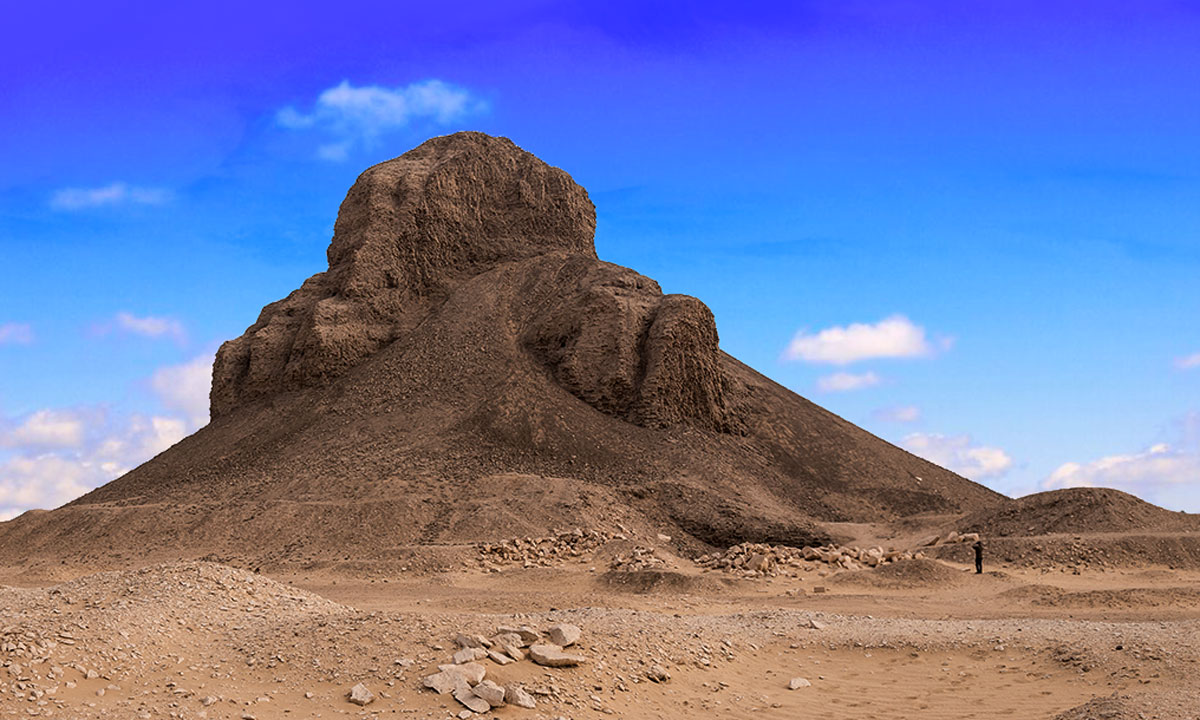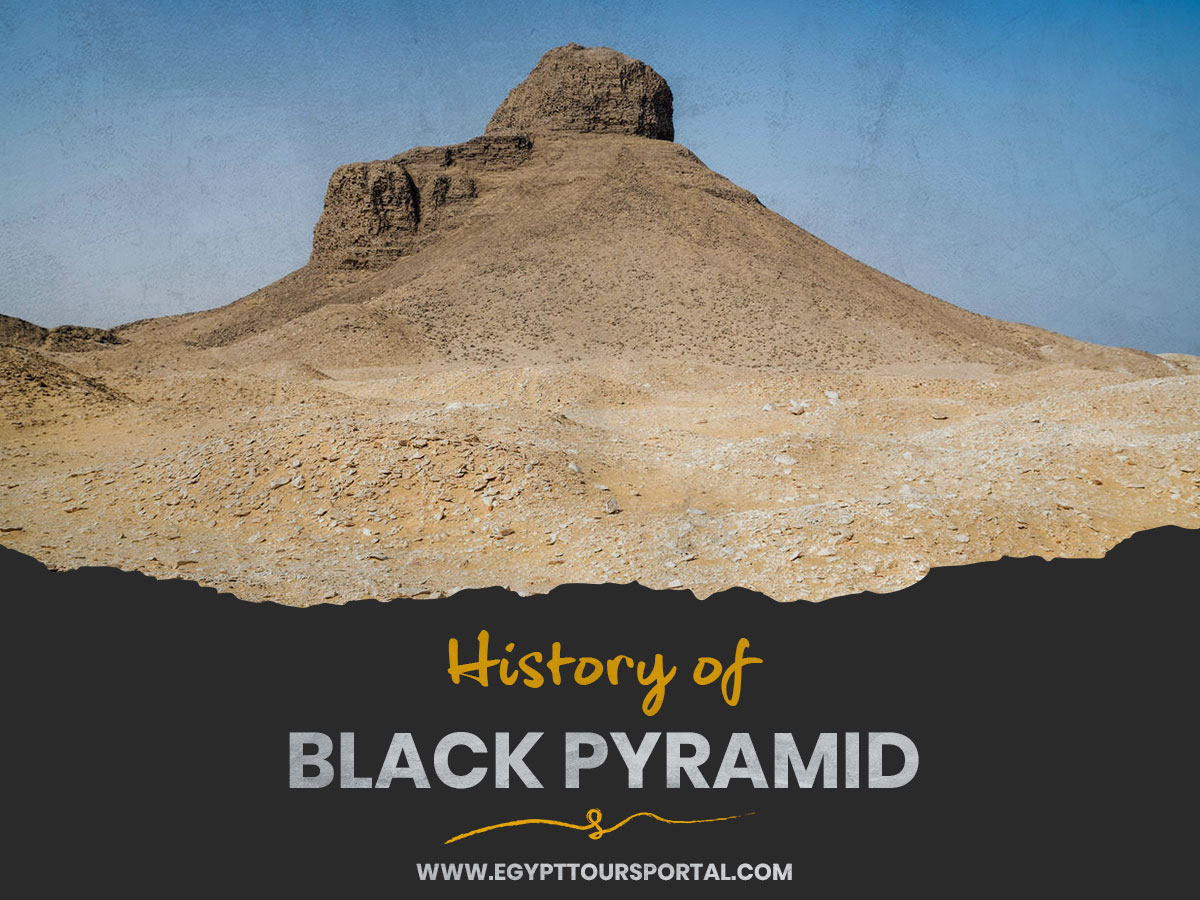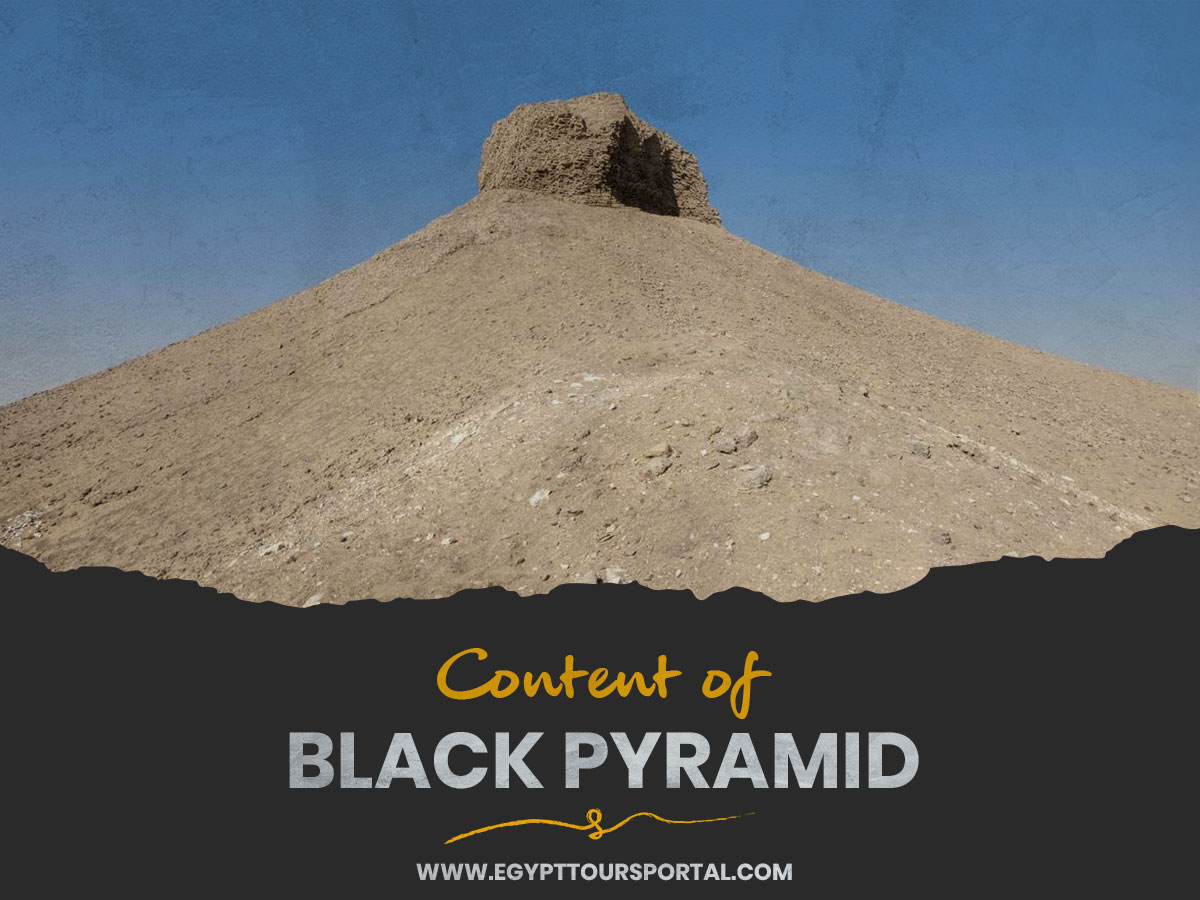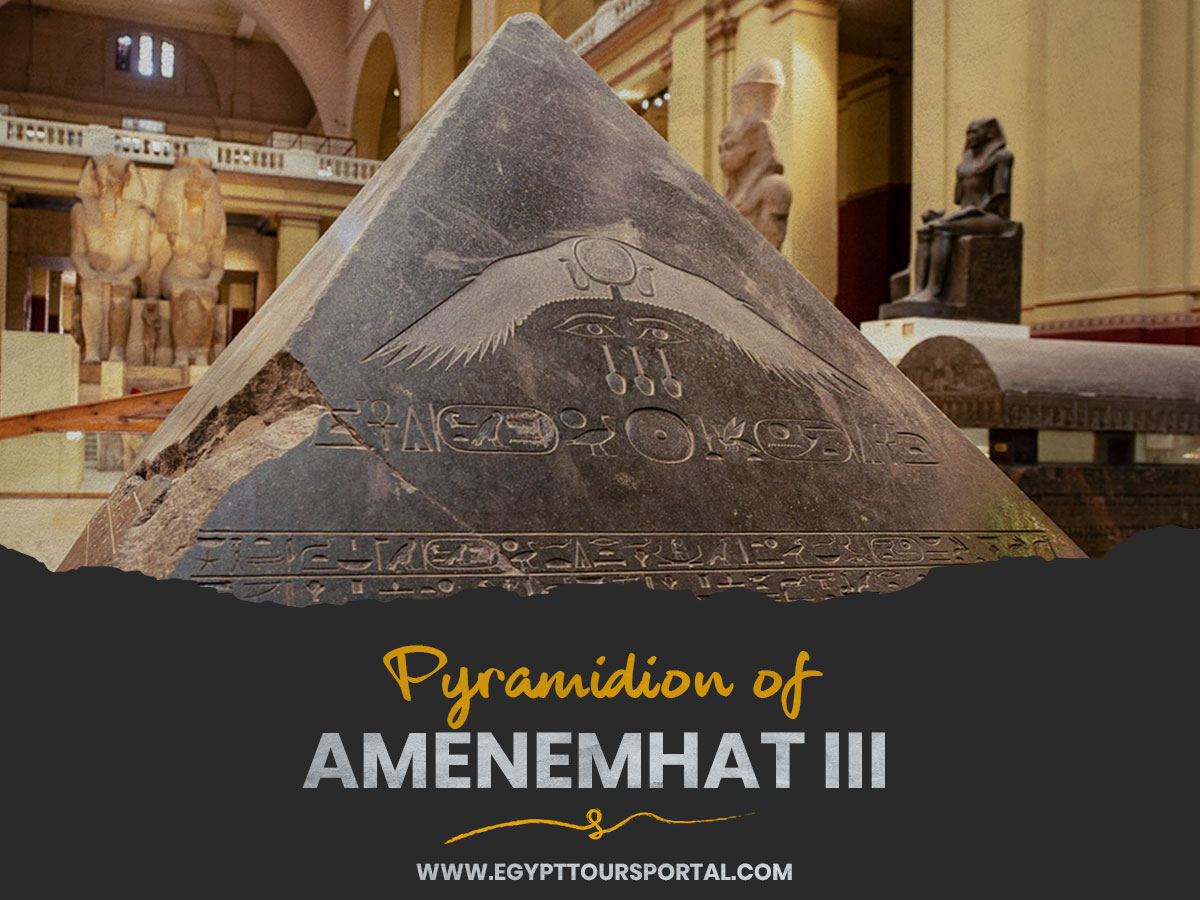Delve into the mystique of Amenemhat III's Black Pyramid—an emblem of ancient Egypt's artistry and history. Uncover its unique construction, sinking secrets, and remote allure in Dahshur, Giza, amidst the legendary pyramids.

| Overview | |

|
|
| Location | Dahshur, Giza, Egypt |
| Founder | King Amenemhat III |
| Building History | Around 1860-1814 BC |
| Period | Middle Kingdom |
| Width | 105 Meters |
| Height | 75 Meters |
| Steep Angle | 57 Degrees |
The Black Pyramid of Amenemhat III is an immortal motto of the creative essence and the strong will of ancient Egypt on their quest to establish an extraordinary wonder that paved the way for the rise of the great pyramids of Giza.
The black pyramid marks the unique respect and imagination of the ancient Egyptians, who utilized the black stones of their terrain to create a special monument that honors the great structures of the Middle Kingdom of Egypt. It offers the chance to catch a glimpse of the ancient Egyptians of the middle kingdom of the holy land of Dahshur trying to preserve the lost art of pyramid creation. This article will provide all the information, in great detail, about this black wonder.

The black pyramid was built by King Amenemhat III (1860 BC- 1814 BC) of the 12th Dynasty (1991 BC – 1802 BC) during the Middle Kingdom of Egypt (2055–1650 BC). It is known to be one of the 5 remaining pyramids of the original 11 pyramids of Dahshur in ancient Egypt. The pyramid is known as the Amenemhat is Mighty, which has also earned the name the black pyramid for its marvelous dark color plus its decaying appearance of a unique rubble mound.
Explore the most important information & facts about the Bent Pyramid of Sneferu read all you need to know about the Bent Pyramid of Dahshur.
Read MoreThe black pyramid was the 1st house and the final resting place of the deceased royal pharaoh and his royal wife-queens. Around 1892, Jacques de Morgan during a French excavation mission took place across the Dahshur area, and again in 1983, the German Archaeological Institute of Cairo completed an excavation mission across the area.
The enigmatic Black Pyramid of Amenemhat III, which was known as "Amenemhat is Mighty and Perfect" is found in the heart of Egypt in the Dahsur area and boasts a striking history filled with fascinating architectural intricacies and mysterious events in Al Marazeek - Dahshour, Al Giza Desert, Giza Governorate.
The coordinates of the Pyramid of Amenemhat III are 29°47′30.0″N 31°13′25″E. The best way to reach this pyramid and uncover its secrets is by booking with a travel agency in order to enjoy easy transportation and the knowledge of a skilled tour guide.

The Pyramid of Amenemhat III is called the "Black Pyramid" because of the color of the mudbrick core that is exposed on the exterior. The mudbrick core was made from a type of clay-rich soil, and it has a dark or blackish color. This dark core is visible because much of the outer casing stones of the pyramid, which would have originally covered and smoothed its surface, have eroded or been removed over the centuries.
These smooth polished white Tura limestone casing stones were highly prized and were often removed and repurposed for other construction projects in old Cairo, leaving the dark mudbrick core exposed, which led to the pyramid being called the "Black Pyramid" due to the striking contrast between the core and the missing casing stones.

The black pyramid of Amenemhat III rises majestically to a towering height of approximately 75 meters, standing as a colossal ancient wonder. Its base stretches to an impressive 105 meters in length. This pyramid has a remarkably steep incline, leaning at an acute 57-degree angle, which is a unique departure from the more common pyramid designs. It was constructed during the Middle Kingdom era and was predominantly made of mud brick and clay, keeping with the architectural traditions of its time. What lends it the mysterious and captivating name "Black Pyramid" is its limestone casing, which encased the mud brick core, thus giving it a distinctive ebony color.
The ground level has an entrance leading to a spacious courtyard known for the presence of a mortuary temple enclosed by sturdy walls. It is a remarkable feature that held the presence of ten shaft tombs ingeniously carved into the natural rock found between two sets of formidable walls. The orientation of the pyramid extends from east to west, with entrances skillfully placed on its southeastern and southwestern corners. The core of the pyramid was a massive edifice of mud brick without internal walls, a decision possibly made due to concerns about the proximity of the structure to the mighty Nile River.
Explore all what you need to know about ancient Egyptian Pyramids, read the most important facts about the builders of Egyptian Pyramids.
Read MoreThe structural challenges faced by the Black Pyramid were evident as it began to sink over time, akin to the famous Bent Pyramid of Sneferu at Dashur. The exterior cladding was a magnificent veneer of limestone held together with dovetail pegs, resulting in final dimensions of about 200 cubits per side and 150 cubits in height, which were truly a testament to the craftsmanship of the era. Beneath the Grand Pyramid is a network of underground passages and chambers that was discovered. The 'King's section' contained a sarcophagus and a canopic jar which was not used for the king's burial. The 'Queen's section' had fallen victim to looters. Four additional burial chambers were unearthed, each shrouded in mystery. While their occupants remain unidentified, speculation suggests that two of them may belong to King Amenemhet IV and Queen Sobekneferu.
As the Black Pyramid slowly sank, desperate attempts were made to install support beams and mud brick walls in an effort to salvage the grand structure. These interventions proved futile, eventually leading to the pyramid's abandonment and its slow descent into obscurity. The Black Pyramid faced numerous structural challenges, which ultimately led to its downfall. Its location in a low-lying area near the Nile allowed groundwater to infiltrate its foundation, weakening the structure over time.
The underground chambers lacked the necessary support from the superstructure above, causing the pyramid to sink. The reliance on mud brick beneath the surface blocks, combined with the removal of the limestone casing, accelerated the deterioration of the structure. These multifaceted issues, along with the intriguing mysteries surrounding its history, make the Black Pyramid of Amenemhat III a truly captivating and enigmatic relic of ancient Egypt.

The mortuary temple is heavily damaged, and there is an open courtyard with 18 granite columns in the shape of holy Papyrus plants. Behind it is an offering hall. The inner walls of the pyramid contain a series of niches that may have held statues of the king.
A wide causeway with a low brick wall on each side connected the black pyramid of Amenemhat III and the mortuary temple with the valley temple which is composed of two open courts raised terrace above the other.
The walls of the lower court formed a gateway that resembled a pylon. In the court, a limestone model of a 13th dynasty pyramid with a subterranean chamber was found. In the west of the pyramid are several tombs belonging to various members, like his daughters, that contain the personal items and jewelry of these princesses.

The magnificent Pyramidion of Pharaoh Amenemhat III is a unique piece of art created around 1850 BC in order to become the capstone that crowned the black pyramid of Dashur. This magical artifact was displayed in the Egyptian museum and remains still. The pyramidion was rediscovered in 1900 during an inspection in the Dashur area after it was attacked by robbers on the guards at the Saqqara necropolis. The basalt capstone is known to measure 1.85 meters in base length and 1.40 meters in height and weighs approximately 4.5 tonnes. Across the four upper faces are a number of intricate inscriptions. The eastern face is able to showcase a sun disk which was flanked by magical uraei and wadjat that represent the king’s eyes, where the sun disk refers to the god Ra, and Nefer stands for beauty. The composition is able to read a certain message, which is "Amenemhat Beholds the Perfection of Ra".
There are a number of marvelous inscriptions found on the bottom of the four upper faces that convey blessings to the royal king. The northern face showcases the king’s exalted status. The eastern face of the pyramidion wished for the king to be the lord of the horizon and cross the magical upper sky. The southern face carries the image of Imiut or Anubis and sheds light on the king's connection with the western desert and his golden inheritance. The western face carries images of Sokar-Osiris and Ptah providing power and life to the king. The name of the god Amun is found in the cartouches of Amenemhat, which has been erased and may have been made during the reign of Akhenaten in the 18th Dynasty, showcasing the pyramidion may have been on the ground since 1350 BC. Some believe the pyramidion’s incredible preservation led to the belief that the pyramidion was never placed on top of the pyramid.
Immerse yourself in the enigmatic world of Egypt's pyramids, traversing through time and marveling at the engineering feats of these historical treasures through our best Egypt pyramids tour packages. Discover Giza's iconic Pyramids and Sphinx, then venture deeper into history at Bent and Red Pyramids in Dahshur and explore the intriguing Medium Pyramid. Our expert-guided tours unveil the secrets of each ancient wonder, offering a rich narrative that spans various pyramids and necropolises. Book now for an immersive journey through Egypt's pyramid legacy!
Private 4 Days Cairo Tour Packages for South African Travelers 4 days Cairo Egypt To...
Tour Location: Cairo – Giza...
5 Days Cairo and Alexandria Tour Package For South African Travelers 5 days Cairo an...
Tour Location: Cairo/Giza/Alexandria...
6 Days Cairo, Luxor & Aswan Tour Package For South African Travelers 6 days Cair...
Tour Location: Cairo/Giza/Aswan/Luxor...
Amazing 7 Days Cairo and Hurghada Holiday for South African Travelers 7 Days Cairo &...
Tour Location: Cairo – Giza – Hurgh...
The pyramidion of Amenemhat III (1860 BC - 1814 BC) is an Egyptian pharaoh of the 12th Dynasty (1991 BC – 1802 BC) during the Middle Kingdom of Egypt (2055–1650 BC) and was most likely made of fine white Tura limestone. The pyramidion was the small capstone that adorned the top of a pyramid. These pyramidions often had inscriptions and were made from high-quality stone to reflect the pharaoh's power and to serve as a protective element for the pyramid structure.
The Black Pyramid, a.k.a the Pyramid of Amenemhat III, was built during the reign of Pharaoh Amenemhat III, who ruled Egypt from around 1860 to 1814 BC in the 12th Dynasty of the Middle Kingdom. It is called the "Black Pyramid" due to the dark color of the mudbrick core of the pyramid, which is visible because most of the outer casing stones have eroded or been removed over time.
The entire country of Egypt deserve to be explored with its every heavenly detail but there are places that must be seen before any other such as the breathtaking Hurghada's red sea, The wonders of Cairo the pyramids of Giza, the great sphinx, the Egyptian Museum, Khan El Khalili Bazaar, the wonders of Luxor like Valley of the Kings, Karnak & Hatshepsut temple and the wonders of Aswan such as Abu Simbel temples, Philea temple, Unfinished obelisk and The Wonders of Alexandria like Qaitbat Citadel, Pompey's Pillar and Alexandria Library. Read more about the best places to visit in Egypt.
If you want to apply for a Visa On Arrival that lasts for 30 days then you should be one of the eligible countries, have a valid passport with at least 6 months remaining and pay 25$ USD in cash, as for the E-Visa for 30 day you should have a valid passport for at least 8 months, complete the online application, pay the e-visa fee then print the e-visa to later be presented to the airport border guard. You could also be one of the lucky ones who can obtain a free visa for 90 days. Read more about Egypt travel visa.
Egypt has a variety of delicious cuisines but we recommend “Ful & Ta’meya (Fava Beans and Falafel)”, Mulukhiya, “Koshary”, a traditional Egyptian pasta dish, and Kebab & Kofta, the Egyptian traditional meat dish.
The best time to travel to Egypt is during the winter from September to April as the climate becomes a little tropical accompanied by a magical atmosphere of warm weather with a winter breeze. You will be notified in the week of your trip if the Climate is unsafe and if any changes have been made.
You should pack everything you could ever need in a small bag so you could move easily between your destinations.
We have been creating the finest vacations for more than 20 years around the most majestic destinations in Egypt. Our staff consists of the best operators, guides and drivers who dedicate all of their time & effort to make you have the perfect vacation. All of our tours are customized by Travel, Financial & Time consultants to fit your every possible need during your vacation. It doesn't go without saying that your safety and comfort are our main priority and all of our resources will be directed to provide the finest atmosphere until you return home.
You will feel safe in Egypt as the current atmosphere of the country is quite peaceful after the government took powerful measures like restructuring the entire tourist police to include all the important and tourist attractions in Egypt. Read more about is it safe to travel to Egypt.
Wear whatever feels right and comfortable. It is advised to wear something light and comfortable footwear like a closed-toe shoe to sustain the terrain of Egypt. Put on sun block during your time in Egypt in the summer to protect yourself from the sun.
The best activity is by far boarding a Nile Cruise between Luxor and Aswan or Vise Versa. Witness the beauty of Egypt from a hot balloon or a plane and try all the delicious Egyptian cuisines and drinks plus shopping in old Cairo. Explore the allure and wonders of the red sea in the magical city resorts of Egypt like Hurghada and many more by diving and snorkeling in the marine life or Hurghada. Behold the mesmerizing western desert by a safari trip under the heavenly Egyptian skies.
There are a lot of public holidays in Egypt too many to count either religious or nation, the most important festivals are the holy month of Ramadan which ends with Eid Al Fitr, Christmas and new years eve. Read more about festivals & publich holidays in Egypt.
Egypt is considered to be one of the most liberal Islamic countries but it has become a little bit conservative in the last couple of decades so it is advised to avoid showing your chest, shoulders or legs below the knees.
Arabic is the official language and Most Egyptians, who live in the cities, speak or understand English or at least some English words or phrases. Fewer Egyptians can speak French, Italian, Spanish, and German. Professional tour guides, who work in the tourism sector, are equipped to handle visitors who cannot speak Arabic and they will speak enough English and other languages to fulfill the needs of all our clients.
The fastest way is a car, of course, a taxi. If you are in Cairo ride a white taxi to move faster or you could board the fastest way of transportation in Egypt metro if the roads are in rush hour.
The temperature in Egypt ranges from 37c to 14 c. Summer in Egypt is somehow hot but sometimes it becomes cold at night and winter is cool and mild. The average of low temperatures vary from 9.5 °C in the wintertime to 23 °C in the summertime and the average high temperatures vary from 17 °C in the wintertime to 32 °C in the summertime. The temperature is moderate all along the coasts.
It is the home of everything a traveler might be looking for from amazing historical sites dating to more than 4000 years to enchanting city resorts & beaches. You will live the vacation you deserve as Egypt has everything you could possibly imagine.









